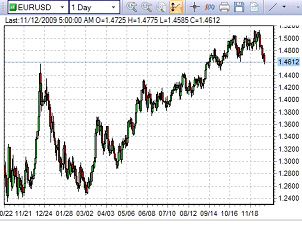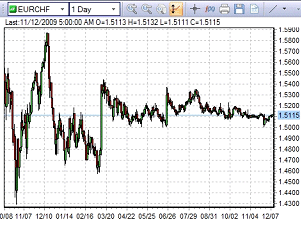Forex range traders often mistake short-term consolidations for ranges. When they go to make a range trade, they discover that the consolidation was not a long-term range, but rather a short-term consolidation which technically appeared to be a range. Ranges occur all the time, and once a range trader can visually see the range, they often assume it will continue. This often results in frustration and losing trades. However, there is a way to isolate currency pairs, which are more likely to stay range bound and are thus more likely to produce profitable trades from a ranging strategy. By actually avoiding currency pairs involving the U.S. dollar (USD) and looking at central bank interest rates for different countries (currencies), an investor can identify these pairs.
The U.S. Dollar Is a Trending CurrencySince many of the global transactions take place in U.S. dollars, currency pairs involving the dollar are exposed to a trending bias, as opposed to a range-bound bias. While ranges do occur in pairs containing the U.S. dollar, trading these pairs with a ranging strategy over the long term is not as efficient as trading pairs that do not contain the U.S. dollar. If you look at major currency pairs involving the U.S. dollar through 2009, you will see that almost all of these pairs had defined trends. These pairs include the EUR/USD, USD/JPY, USD/CHF, USD/CAD and AUD/USD. These pairs did not move in straight lines in one direction, but it is obvious that any ranges that occurred did not last for long periods of time. Unfortunately, the non-U.S. dollar rule is not 100% accurate, as the GBP/USD did hold relatively well within a range through the last six months of 2009. (For a primer on currency trading, refer to our comprehensive Forex Tutorial.)
But let's look at the most popular currency pair, the EUR/USD. Many traders will trade this pair with any strategy simply because it does the most volume, but it is not the best pair for range trading as can be seen in Figure 1.

In context, if we look at cross-currency pairs we see more of a propensity to stay within a range. Some ranges are very volatile, while others are more controlled. If we look at 2009 for pairs such as the EUR/JPY, GBP/JPY, GBP/CHF, AUD/NZD, we see more ranging environments. The EUR/CHF (Figure 2) is a great example: while it did experience volatility along with other currency pairs toward the end of 2008 in the financial crisis, it stabilized and held within a 450 pip range for the last eight months of 2009.

An overall trending bias in pairs containing the U.S. dollar weakens the probability for profitable range-bound trades on all times frames. While a pair that generally does not trend strongly increases the probability of ranging strategies being successful on all times frames.
Of course, this is not 100% accurate. Some pairs containing the U.S. dollar will be range bound for long periods of time, and a cross-currency pair may also trend for a long period of time. Therefore, we need to filter through which cross-currency pairs are best for range trading. Looking at long-term charts is one way to do this; another is to look at interest rate differentials.
Interest Rate Differentials Affect VolatilityIn range trading, there are very volatile pairs that do not trend but that have movements that are erratic and disproportional to previous moves. Then there are pairs that move more rhythmically. The interest rate differential between two countries (currencies) can play a large role in determining these movements. In December 2009, the Reserve Bank of Australia had interest rates at 3.75%, while the Bank of Japan had interest rates at 0.10%, a 3.65% interest rate differential. The AUD/JPY had a average (14 week) true range of 338 pips. If we compare Australia (AUD) to New Zealand (NZD), which had interest rates at 2.5%, only a 1% differential, the average true range (14 weeks) for the AUD/NZD was 230 pips in December 2009.
We can also look at other examples, such as the GBP/JPY, which as of December 2009 had an average weekly (14) true range of 560 pips. The interest rate differential of these currencies is 0.40% (GBP=0.50% and JPY=0.10%). There are other factors that affect volatility, but interest rate differential among currencies pairs is definitely one to watch.
Don't just look at interest rate differentials at one point in time, but rather the relationship over time. While the GBP/JPY interest differential was only 0.40% in December 2009, back in 2007 the differential was 4.50% or higher. Therefore, historically the differential indicates this is a volatile pair.
Picking the Pairs to Range TradeUltimately, traders will need to decide for themselves what type of pairs they will range trade. Typically, pairs that do not contain the U.S. dollar are more suitable for range trading. Pairs that have a historically low interest rate differentials are also suitable for range trading.
Long-term charts will give us a good idea of the countries' relationship over time. When we consider an example noted above, the EUR/CHF, it is logical to assume, when we consider how these countries are interlinked, that the pair will not move drastically except in extreme circumstances. It is not likely the Eurozone would suffer disaster without it affecting the CHF or vice-versa. The U.S. and Australia are not as directly linked, and may be exposed to different geopolitical events, thus creating trends as the countries emerge and pull out of phases of the economic cycle at different times.
Just because certain pairs have the prerequisites for a good range trade candidate, doesn't mean that the pair will trade within a range all the time. Proper risk management and solid trading strategy must be implemented. By isolating pairs that satisfy our prerequisites, we stand a greater chance of profiting from our range trading methodology because we are making trades in currency pairs that actually complement the strategy. (Learn about some proper ways to manage risk in Risk Management Techniques For Active Traders.)
The Bottom LineSuccessful range trading in the forex market involves more than just visually seeing a range. We can increase our chances of profitability by isolating pairs that do not have a tendency to trend; namely, by excluding pairs that include the U.S. dollar. From the cross-currency pairs, we can then look at long-term charts to see if they have trending bias, and then filter this by looking at the relationship of their interest rate differentials. High interest differentials generally mean increased volatility. Cross-currency countries that are highly interlinked will likely decrease volatility and make the currencies more likely to range. We still need to have a proper range-trading strategy, but by putting the pairs we range trade through our prerequisite screen we stand a better chance of making more profitable range trades.